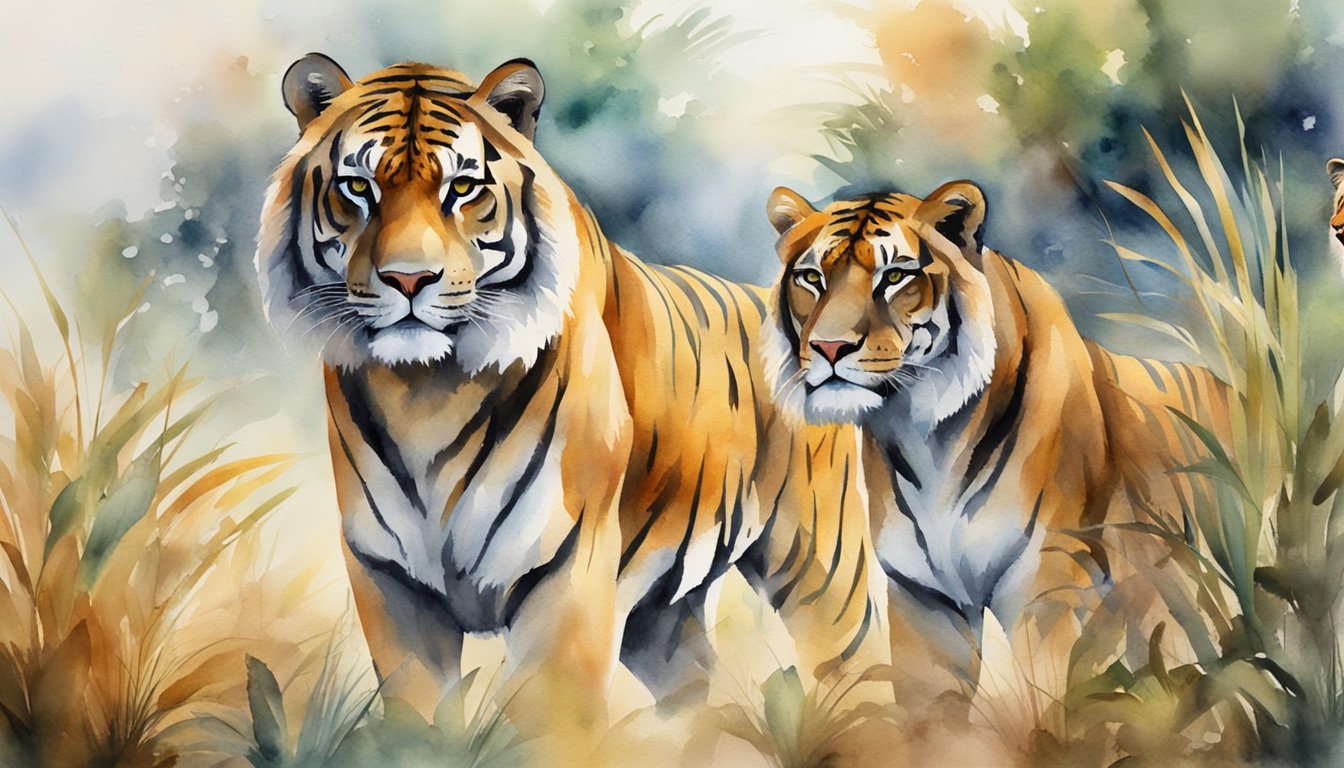Physical Characteristics
Discussing the physical attributes of lions and tigers reveals quite a lot about how these majestic creatures are built for their individual lifestyles and habitats.
Comparative Size and Weight
Lions and tigers are among the largest predators in the cat family. A male lion’s weight typically ranges from 330 to 550 pounds, while tigers generally weigh a bit more, with the Siberian tiger, for instance, often exceeding 660 pounds. As for body length, tigers are longer than lions, thanks to their longer tails.
Distinct Features
A prominent feature distinguishing male lions is their mane, which not only makes them appear larger and more intimidating but also provides protection during fights. Tiger stripes are unique to each individual and serve as camouflage. Tigers have a more muscular build compared to lions, which is well-adapted to their solitary hunting style.
Subspecies Variations
There are several subspecies of both lions and tigers, which display variations in size, fur, and coloration. Lions have subspecies like the Asiatic lion, whereas tigers boast different subspecies such as the Siberian tiger, which is the largest and can have a body length of over 12 feet including the tail. The coloration and patterns of their fur are indicative of the region they inhabit, with some subspecies adapted to colder climates with thicker fur coats.
Habitat and Lifestyle

Tigers and lions are among the most majestic and fascinating of the big cats, each boasting its own unique lifestyle and habitat preferences. Tigers are often associated with the dense forests of Asia and primarily found in regions like India. They are solitary creatures, preferring to roam large territories alone, which can range up to hundreds of square kilometers. This apex predator is highly adaptable and can be found in a variety of habitats including grasslands, woodlands, and mangroves.
- Territory: Solitary, expansive range
- Habitat: Forests, grasslands, woodlands
- Location: Mainly Asia, especially India
In contrast, lions are synonymous with Africa, although a small population exists in India as well. They thrive in the Savannah, bush, and grasslands, where their tawny coats blend into the dry landscape. Unlike their tiger counterparts, lions are incredibly social animals, living in groups known as prides. These prides have a complex social structure and work together to defend territory and hunt. A lion’s range is smaller compared to a tiger’s, as their cooperative lifestyle means less need to cover extensive ground to find food or mates.
- Territory: Social, living in prides
- Habitat: Savannah, bush, grasslands
- Location: Mostly Africa, small population in India
While both are apex predators in their respective environments, their approach to hunting reflects their lifestyle: Tigers often rely on stealth and power to capture their prey, whereas lions use the strength of their pride to take down animals. It’s this balance of power and social dynamics that have allowed both big cats to become the rulers of their realms – the tiger as the solitary monarch of the Asian forests, and the lion as the communal king of the African plains.
Interactions and Conflict

When picturing a lion and a tiger in the same space, one might imagine an epic battle between two of the largest big cat species. In reality, these magnificent cats have different habitats and behaviors, leading to limited direct interactions in the wild. Historically, however, the ranges of Asiatic lions and tigers did overlap in some parts of Asia.
Tigers tend to be solitary creatures, often requiring large territories to support their hunting needs. Males can be especially territorial, willing to engage in combat to defend their range. Lions, on the other hand, are social animals living in prides. Male lions protect their pride’s territory and, most importantly, their cubs. In these social structures, strength and dominance are crucial.
A clash between a tiger and a lion would likely involve a display of power. Males of both species have been known to fight to the death, though this is rare, as fights are energy-consuming and potentially fatal. Disputes are usually settled with visual and vocal displays before escalating to physical combat.
| Lion Traits | Tiger Traits |
|---|---|
| Social | Solitary |
| Prides | Individual territories |
| Vocal | Stealthy hunters |
Ligers and tigons, hybrids born from lion and tiger pairings, are evidence of the two species’ ability to interbreed under artificial conditions, such as captivity. While intriguing, these hybrids would not occur naturally in the wild.
When considering lion vs tiger scenarios, keep in mind that these animals are adapted to different lifestyles and habitats, making coexistence more likely than conflict, though their interactions could be intense if they ever meet face-to-face.

